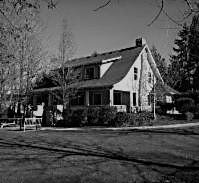L 88.40.01 - James and Anna Clise, with dog Toby, at Willowmoor.
Anna and James Clise had lost their son, Willis, to juvenile arthritis in 1898. At that time, there were no hospitals in the Seattle area to treat children. In her grief, Anna sought a way to ease the suffering of other mothers and children. After visiting Dr. John Musser at Philadelphia Orthopedic in 1906, Anna was moved to action. In 1907, she organized a group of 23 other wealthy Seattle women to establish a hospital of their own.
Anna was elected the first President of the Board of Trustees of Children’s Orthopedic Hospital Association. They started with a seven bed ward in Seattle General Hospital and had an all-female board. In their first year, the Association was approached by the Dorcas Society about a 14-year-old black girl with tuberculosis of the knee. When asked if they would help her, the Association pledged to accept any child, regardless of race, religion, or the parents’ ability to pay. That year the doctors of the ward treated 13 children and performed 7 operations.
The Clise’s owned the property that is today known as Marymoor Park, in Redmond. There they hosted many lavish parties to help fund this new hospital. Guests were met at the ferry dock with a four-horse tallyho and transported to the 350 acre estate. Anna’s daughter Ruth recalled, “Gaily colored Japanese lanterns holding lighted candles were strung between the trees in the garden and down to the river, where their reflections created a romantic setting. The large rooms of the house and the spacious verandas provided ample room for dancing, the music drifting out over the garden.”
As word spread about the work they were doing, the Association quickly outgrew the ward at Seattle General. In 1908, they opened the “Fresh Air Cottage” on Queen Anne Hill with 12 beds. In 1911, they built an even larger 50-bed hospital next door. The hospital remained there until 1953, when it moved to its current location in the Laurelhurst neighborhood.
By 1917, Anna had lost her eyesight to glaucoma and the couple decided to retire to their property in California. She maintained an interest in the Children’s hospital throughout her remaining years and her daughter and granddaughter served as trustees. Anna died of cancer in 1936.
Anna Clise was included in the Washington State Centennial Hall of Honor in 1989.
To learn more about the Clise family and their Willowmoor estate, visit our latest online exhibit: Willowmoor.
Resources
"The Washington State Centennial Hall of Honor." Columbia Magazine. 3.2 (Summer 1989): 3639. http://columbia.washingtonhistory.org/magazine/articles/1989/0289/0289‐a2.aspx.
Woman's Place: a Guide to Seattle and King County History, by Mildred Tanner Andrews, Gemil Press, 1994, pp. 154–155.
Johnston, Helen, and Richard Johnston. Willowmoor: the Story of Marymoor Park. King County Historical Association, 1976.






